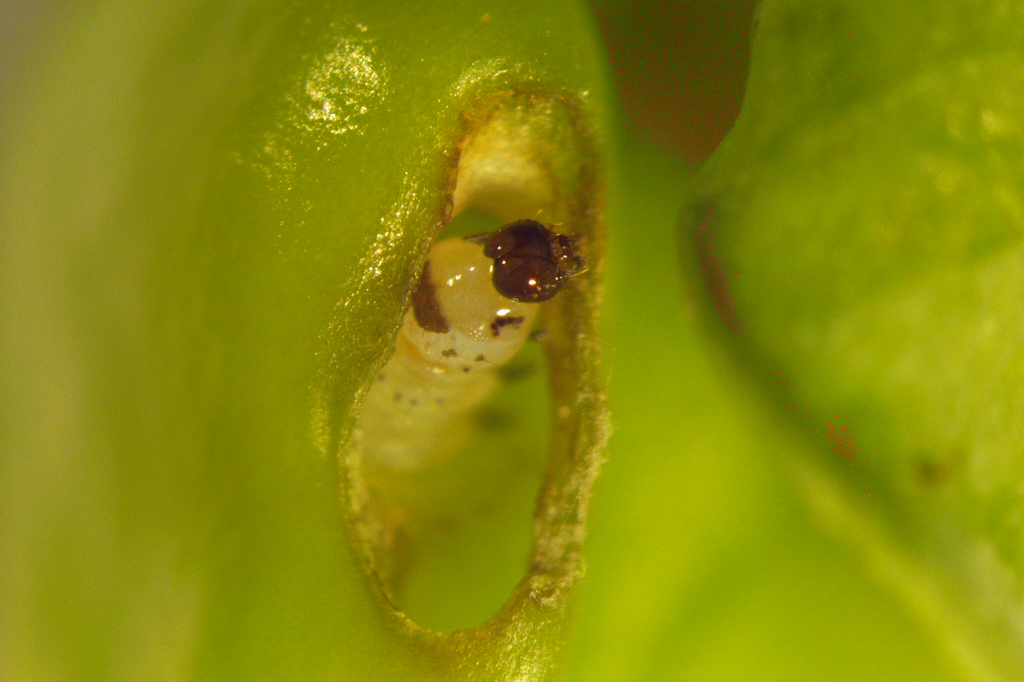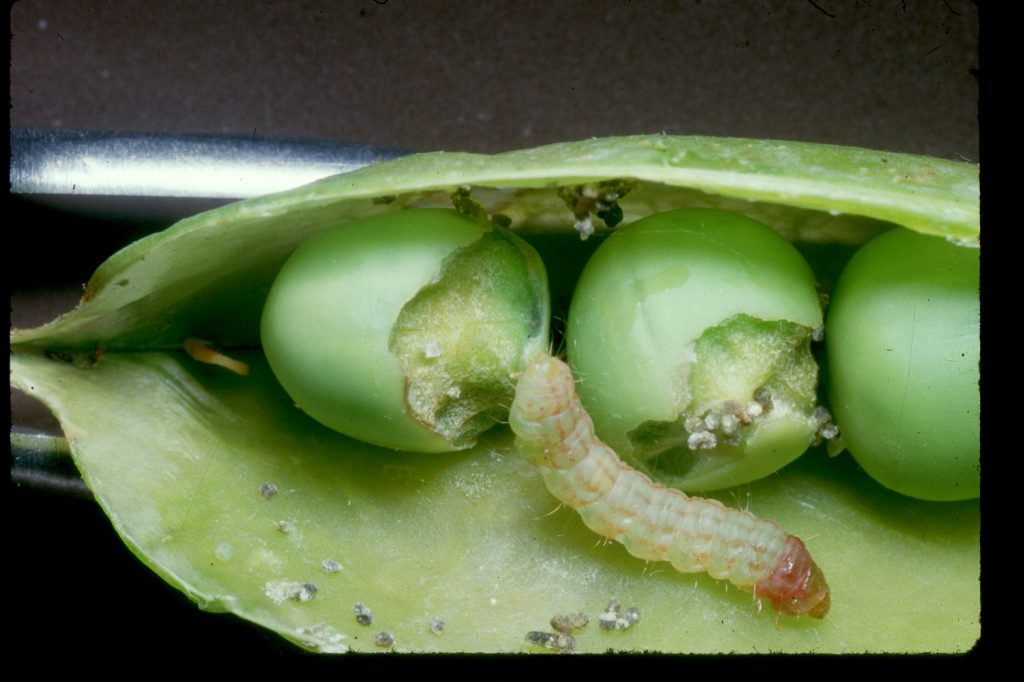Lucerne seed web moth or Etiella
Etiella behrii
Other common names
Etiella

Photo by SARDI
Summary Top
Lucerne seed web moths have a protruding beak and a distinctive white stripe along the edge of the forewing. Larvae have pinkish-red stripes and are particularly damaging to lentils and lucerne. The risk period is when pods are green. Dry pods are not at risk.
Once eggs have been laid and larvae have bored into seed pods, insecticide applications are mostly ineffective as the larvae are protected from contact sprays.
Occurrence Top
The lucerne seed web moth, also referred to as ‘Etiella’, is widespread throughout Australia. Although they only occur sporadically, when present they are potentially a very serious pest of agricultural crops in Western Australia, South Australia, Victoria, New South Wales and Queensland.
Description Top
Adult moths are 10-15 mm long, greyish-brown in colour and when at rest they are long and slender in appearance. They have a tan coloured band that runs across the forewings and a white strip that runs the full length along the outer edge of the forewings. Moths also have a snout-like beak, which protrudes forward from the head. Eggs are clear in colour and change to orange prior to hatching.
Early instar larvae are pale green or sometimes cream, with distinctive pink stripes along their body. As larvae mature they become pinker in colour and the stripes redden. Larvae have four pairs of abdominal prolegs and one anal proleg. They grow up to 12 mm long. Younger larvae have dark brown head capsules, but as they mature this turns to a light brown colour.



Lifecycle Top
Lucerne seed web moth or Etiella can have up to three generations per year occurring from spring to autumn. Larvae from the previous autumn overwinter in the soil and adults emerge from September. Adult females are capable of laying approximately 200 eggs that are laid on the surface of leaves, stems and flowers and hatch in from 1-14 days depending on temperature. Shortly after larvae hatch they bore into seedpods where they feed as they grow. In summer pulses larvae complete development in a single pod before boring out through a pin-sized hole. First moth flights usually take place during September.


Behaviour Top
When Etiella eggs hatch, the small larvae spins a protective web around itself, hence the name, lucerne seed web moth. When infested crops are disturbed, adult moths can be seen making short flights, landing on the undersides of foliage.
Similar to Top
Weed web moth and cabbage centre grub caterpillars.
Crops attacked Top
Predominantly lentils and lucerne, but also found in lupins, field peas, peanuts, soybeans, vetch, medics and clovers.
Damage Top
Shortly after larvae hatch they bore into seedpods, which creates small ‘pin-holes’. As the larvae develop they feed on the seed causing seed damage and yield losses. Mature larvae will damage more than one single pod and have the ability to web seedpods together to continue their feeding regime. Major damage caused by larvae is indicated by the jagged remains of eaten seeds and quantities of frass in pods.
In winter pulses only the spring generation causes damage.




Monitor Top
Start to monitor crops in spring during early pod development. This will coincide with the first moth flights, which usually take place during September. There are various monitoring tools:
• Use the degree-day model produced by SARDI to help identify the predicted onset of moth flights and when critical crop monitoring will be required. (The model requires that you add local maximum and minimum temperatures, beyond June 21st, to the spreadsheet).
• Use pheromone traps to monitor moth flights in paddocks by a placing a minimum of two traps 25 cm above the crop. Light traps are another means of monitoring moth numbers.
• A sweep-net can be used to monitor larval activity, and seedpods should be checked visually for the presence of grubs. A minimum of three groups of 20 sweeps taken randomly across the paddock will be required to accurately check for pest activity.
Economic thresholds Top
An indicative threshold for lentils is 2 or more adult moths per 20 sweeps. In lucerne, control may be warranted if about 5% of seed pods contain small larvae (Bailey, 2007).
Management options Top
Biological
There are several parasitic wasps and flies that attack the larvae of lucerne seed web moths. Predatory bugs such as the glossy shield bug and predatory shield bug also prey upon larvae.
Cultural
Time of sowing and variety selection (early maturing varieties) can result in crops flowering and setting pods prior to peak activity of lucerne seed web moths.
Control volunteer legumes and other host plants to prevent population development.
Chemical
There are several insecticides registered against lucerne weed web moth. Insecticides should be considered when moth activity is first observed in lentil crops. Once eggs have been laid and larvae have bored into seed pods, insecticide applications are mostly ineffective as the larvae are protected from contact sprays.
Acknowledgements Top
This article was compiled by Paul Umina (cesar) and Bill Kimber (SARDI).
References/Further Reading Top
Bailey PT. 2007. Pests of field crops and pastures: Identification and Control. CSIRO Publishing, Melbourne, Australia.
Bellati J, Mangano P, Umina P and Henry K. 2012. I SPY Insects of Southern Australian Broadacre Farming Systems Identification Manual and Education Resource. Department of Primary Industries and Resources South Australia (PIRSA), the Department of Agriculture and Food Western Australia (DAFWA) and cesar Pty Ltd.
Krawec C, Hopkins, D, and Baker, GJ. 2006. Predicting spring flights of Etiella behrii (Lepidoptera: Pyralidae): a pest of lentils in southern Australia. GRDC Final report. finalreports.grdc.com.au/view_attachment.php?attachment_id=4960
Brier, H. 2013. Etiella outbreak in vegetative soybeans on the Darling Downs. The Beat Sheet http://thebeatsheet.com.au/crops/pulses/soybeans/etiella-outbreak-in-vegetative-soybeans-on-the-darling-downs/
| Date | Version | Author(s) | Reviewed by |
|---|---|---|---|
| January 2015 | 1.0 | Paul Umina (cesar) and Bill Kimber (SARDI) | Garry McDonald (cesar) |
What are PestNotes?
PestNotes are information sheets developed through a collaboration between Cesar Australia and the South Australian Research and Development Institute (SARDI). Copyright: © All material published in PestNotes is copyright protected by Cesar Australia and SARDI and may not be reproduced in any form without written permission from both agencies.
Disclaimer
The material provided in PestNotes is based on the best available information at the time of publishing. No person should act on the basis of the contents of this publication without first obtaining independent, professional advice. PestNotes may identify products by proprietary or trade names to help readers identify particular products. We do not endorse or recommend the products of any manufacturer referred to. Other products may perform as well as or better than those specifically referred to. Cesar Australia and PIRSA will not be liable for any loss, damage, cost or expense incurred or arising by reason of any person using or relying on the information in this publication. Any research with unregistered pesticides or products referred to in PestNotes does not constitute a recommendation for that particular use.

